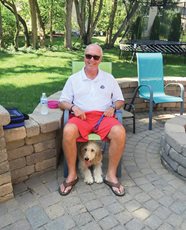Patient Story: Terry Fout
 On November 30, 2015, Terry was driving alone in Dublin, Ohio, when he lost control of his car. In agonizing pain, he was transported to Riverside Methodist Hospital, which was nearby in Columbus. The emergency physicians determined that Terry had suffered a severe compression fracture of his L1 vertebra, located just above his waistline. He underwent a four-hour surgery the next day to remove the broken vertebra, implant a titanium spinal cage in its place, and fuse two vertebrae to the spinal cage.
On November 30, 2015, Terry was driving alone in Dublin, Ohio, when he lost control of his car. In agonizing pain, he was transported to Riverside Methodist Hospital, which was nearby in Columbus. The emergency physicians determined that Terry had suffered a severe compression fracture of his L1 vertebra, located just above his waistline. He underwent a four-hour surgery the next day to remove the broken vertebra, implant a titanium spinal cage in its place, and fuse two vertebrae to the spinal cage.
“At that point, there were a lot of unanswered questions about my recovery,” Terry recalled. “I knew it was a miracle that my injuries were not more severe. My spinal cord had not been damaged, so I was able to walk with a walker within a few days. However, any twisting or bending motion caused a great deal of pain, so I was very limited in what I could do. No one could tell me whether my limitations were permanent. One big question I had was, ‘Would I be able to golf again?’ That was very important to me.”
Eight days after Terry’s surgery, he was dismissed from Riverside with the recommendation to participate in an inpatient rehabilitation program. His son, Drew, made arrangements for Terry to be admitted immediately to LMH’s ARU. Drew works in the Engineering Services Department at LMH, and he knew that the ARU staff would provide the attention and encouragement his father needed.
However, Terry discovered from the onset that he was not going to be coddled. “The staff expects you to do your part,” he said. “My rehabilitation began just seven minutes after I arrived. I requested help for a small task that had been too difficult for me. They told me that they would provide assistance if I really needed it; however, I should try to do it for myself first.”
Terry appreciated this compassionate-yet-challenging approach to his rehabilitation. “The next morning, the occupational therapist brought in bathing and shaving equipment, and I washed myself for the first time since the accident. She chatted with me and stayed nearby in case I needed help, but she wanted me to learn to take care of myself. The entire staff was dedicated to helping me recover enough that I could function well at home,” Terry said.
Terry’s daily routine in the ARU consisted of occupational therapy which included cooking and laundry activities, physical therapy, moderate activity and socialization. “The staff was creative in my rehabilitation,” he said. “One day, I helped wrap Christmas presents for an Adopt-a-Family project. That seemed simple enough, but it was actually very therapeutic because it involved walking, standing, hand coordination, and doing something while talking to others. They also encouraged me to have my meals with others in the ARU’s dining room. I realize now how important the socialization was to my recovery. They didn’t want me to lie in bed and think about the accident.”
As a retired educator and coach, Terry has been athletic and goal-oriented all his life, so it was natural that he would measure his recovery by achieving personal goals. “At first, my goal was to watch one of my grandsons wrestle at Licking Valley High School in January – I did that. My next goals were to walk on Ocean Isle Beach in North Carolina and to play nine holes of golf. I walked on the beach in June, and I played nine holes of golf four separate times over the summer. Then, I set a big goal for myself – I wanted to play 18 holes of golf on my birthday which was September 10. I’m happy to say that I achieved that as well!”
During his two-week stay in the Hospital’s ARU, Terry maintained a motto that he calls his “ABCs,” which stand for ambition, balance and communication. “‘Ambition’ refers to goal-setting, ‘balance’ means ensuring that my goals are in line with what I can realistically achieve, and ‘communication’ means that I express my appreciation for others. It’s so important to be positive and not complain. I was very happy to see that the ARU staff followed the same principles. I believe that remaining positive was the biggest step in my recovery.”
Terry also appreciated the staff’s warmth toward his family. “My wife, Kathie, was more than elated with the care,” he stated. “Whenever Kathie and our daughter, Erin, came to visit, the staff greeted them and knew them by name. My son was welcome to stop by anytime or to share lunch, and it was a blessing to have these rehabilitative services close to home so Kathie could go home every night after visiting me. She felt comfortable knowing that I was in
good care.”
The ARU opened on the LMH’s sixth floor in 2012. The department is staffed by a dedicated team comprised of a medical director, nurses, physical therapists, occupational therapists, speech therapists, social workers, psychologists and other Hospital personnel.
| Posted On : 11/4/2016 2:52:48 PM